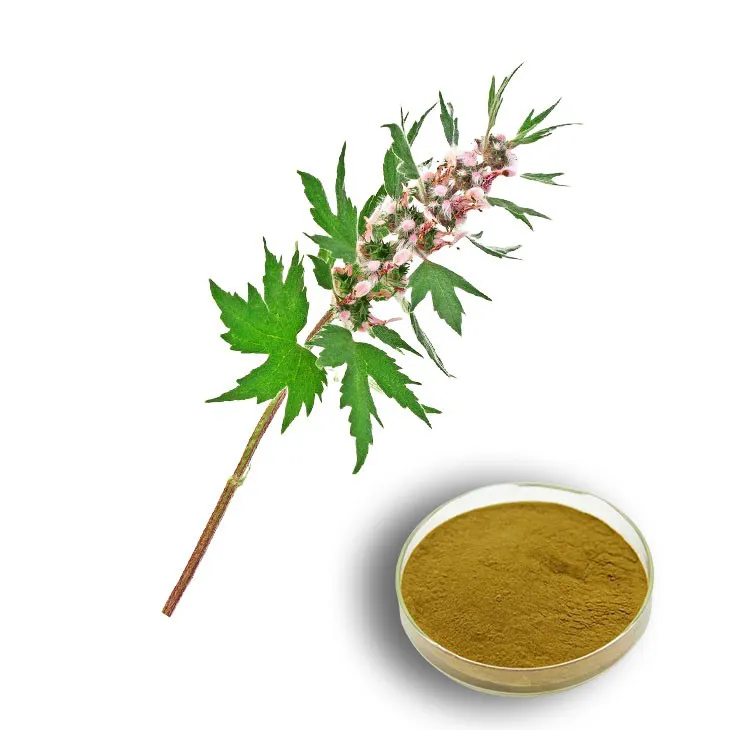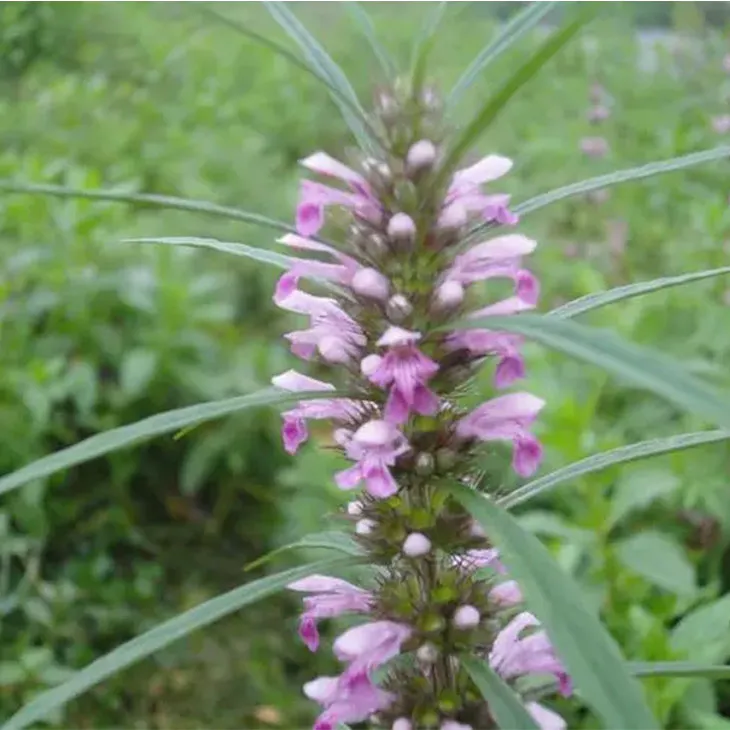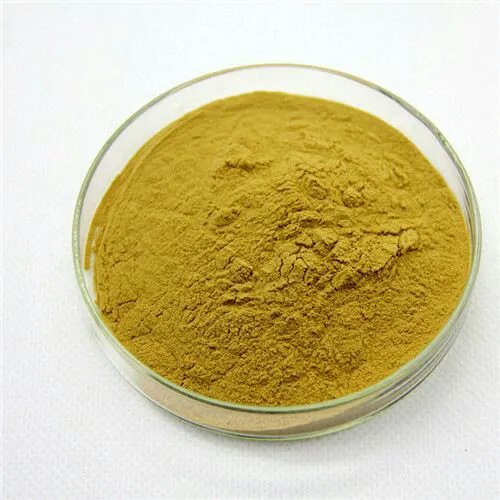- 0086-571-85302990
- sales@greenskybio.com
The Optimal Method for Extracting Motherwort Extract.
2024-11-28

1. Introduction
Motherwort (Leonurus cardiaca) has been used in traditional medicine for centuries due to its various potential health benefits. Motherwort Extract is rich in bioactive compounds such as alkaloids, flavonoids, and diterpenes, which are believed to contribute to its medicinal properties. Extracting Motherwort Extract efficiently is crucial for obtaining high - quality products with maximum bioactivity. In this article, we will explore both traditional and modern extraction methods, taking into account important parameters like solvent choice, extraction time, and temperature.

2. Traditional Extraction Methods
2.1. Maceration
Maceration is one of the simplest and most traditional methods of extracting Motherwort Extract.
-
First, the dried motherwort plant material is finely ground to increase the surface area available for extraction. This helps in better contact between the plant material and the solvent.
-
A suitable solvent, such as ethanol or water, is then added to the ground motherwort. The ratio of solvent to plant material is an important factor. For example, a common ratio could be 10:1 (solvent to plant material by weight).
-
The mixture is then left to stand at room temperature for a period of time, usually several days to weeks. During this time, the solvent gradually penetrates the plant cells and dissolves the bioactive compounds.
-
After the maceration period, the mixture is filtered to separate the liquid extract from the solid plant residue. The resulting liquid is the motherwort extract, which can be further concentrated if needed.
However, maceration has some drawbacks. It is a relatively slow process, and the extraction efficiency may not be as high as some modern methods. Also, there is a risk of microbial growth during the long extraction period, especially if water is used as the solvent.
2.2. Decoction
Decoction is another traditional extraction method, which is commonly used in herbal medicine.
-
The dried motherwort is added to a pot of water. The amount of water used depends on the quantity of motherwort, but a general rule is to use enough water to cover the plant material completely.
-
The water - motherwort mixture is then heated to boiling and maintained at a boiling temperature for a certain period, usually 15 - 30 minutes. Boiling helps to break down the plant cell walls and release the bioactive compounds into the water.
-
After boiling, the mixture is allowed to cool, and then it is filtered to obtain the decocted motherwort extract.
One advantage of decoction is that it can quickly extract water - soluble compounds from motherwort. However, it may not be suitable for heat - sensitive compounds, which may be degraded during the boiling process. Also, the extract obtained by decoction may have a relatively high water content, which may require further concentration or drying.

3. Modern Extraction Methods
3.1. Soxhlet Extraction
Soxhlet extraction is a widely used modern extraction method for motherwort.
-
The dried and ground motherwort is placed in a Soxhlet thimble. A Soxhlet apparatus consists of a flask, a condenser, and a thimble holder.
-
A suitable solvent, such as ethanol or a mixture of ethanol and water, is added to the flask. The solvent is then heated to reflux.
-
As the solvent vaporizes, it rises through the condenser, where it is condensed back into a liquid and drips onto the motherwort in the thimble. This continuous extraction process gradually dissolves the bioactive compounds from the motherwort.
-
The extraction continues until a sufficient amount of the bioactive compounds has been extracted. This can be determined by analyzing the extract at regular intervals.
-
Once the extraction is complete, the solvent is evaporated from the extract, leaving behind the motherwort extract.
Soxhlet extraction has the advantage of being a relatively efficient method, especially for extracting compounds that are less soluble in the solvent at room temperature. However, it also has some limitations. It is a time - consuming process, and the high temperature and long extraction time may cause some degradation of heat - sensitive compounds. Additionally, the use of large amounts of solvent may pose environmental and cost - related issues.
3.2. Ultrasonic - Assisted Extraction
Ultrasonic - assisted extraction (UAE) is a modern and efficient method for extracting motherwort extract.
-
The dried and ground motherwort is placed in a container with a suitable solvent, such as ethanol or water - ethanol mixtures.
-
An ultrasonic generator is then used to generate ultrasonic waves, which are transmitted into the solvent - motherwort mixture.
-
The ultrasonic waves create cavitation bubbles in the solvent. When these bubbles collapse, they generate high - pressure and high - temperature micro - environments. These micro - environments help to break down the plant cell walls and enhance the mass transfer of the bioactive compounds from the plant material to the solvent.
-
The extraction time is usually much shorter compared to traditional methods, typically ranging from 10 - 60 minutes.
-
After the extraction, the mixture is filtered to obtain the motherwort extract.
UAE has several advantages. It is a relatively fast and efficient method, and it can be used to extract both heat - sensitive and non - heat - sensitive compounds. Moreover, it requires less solvent compared to some other methods, which is beneficial from both environmental and cost - perspectives. However, the equipment for ultrasonic - assisted extraction can be relatively expensive, and the extraction efficiency may be affected by factors such as the power of the ultrasonic generator and the frequency of the ultrasonic waves.
3.3. Supercritical Fluid Extraction
Supercritical fluid extraction (SFE) is a state - of - the - art extraction method for motherwort.
-
In SFE, a supercritical fluid, usually carbon dioxide (CO₂), is used as the extraction solvent. CO₂ is chosen because it is non - toxic, non - flammable, and has a relatively low critical temperature (31.1 °C) and pressure (73.8 bar).
-
The dried motherwort is placed in an extraction vessel. The supercritical CO₂ is then pumped into the vessel at a controlled temperature and pressure above its critical point.
-
The supercritical CO₂ has unique properties that allow it to penetrate the plant cells and dissolve the bioactive compounds. The dissolved compounds are then carried out of the extraction vessel along with the supercritical CO₂.
-
By adjusting the temperature and pressure, the selectivity of the extraction can be controlled, which means that specific compounds can be preferentially extracted.
-
After the extraction, the supercritical CO₂ is depressurized, and the dissolved compounds are separated from the CO₂, resulting in the motherwort extract.
SFE has many advantages. It is a clean and environmentally friendly method, as CO₂ is a natural and non - polluting solvent. It also provides high extraction selectivity, which can result in a purer extract with a higher concentration of the desired bioactive compounds. However, the equipment for supercritical fluid extraction is very expensive, and the operation requires high - level technical expertise.

4. Solvent Choice
The choice of solvent is a crucial factor in motherwort extraction. Different solvents have different solubilities for the bioactive compounds present in motherwort.
-
Ethanol: Ethanol is a commonly used solvent for motherwort extraction. It has good solubility for a wide range of bioactive compounds, including alkaloids and flavonoids. Ethanol - based extracts are also relatively easy to handle and store. Moreover, ethanol is a relatively safe solvent compared to some other organic solvents.
-
Water: Water is a natural and inexpensive solvent. It is very effective for extracting water - soluble compounds from motherwort, such as some flavonoids and polysaccharides. However, water - based extracts may have a higher risk of microbial contamination, and they may require additional processing steps, such as drying or adding preservatives.
-
Mixtures of Ethanol and Water: A mixture of ethanol and water can combine the advantages of both solvents. By adjusting the ratio of ethanol to water, it is possible to optimize the solubility of different bioactive compounds. For example, a higher ethanol content may be more suitable for extracting alkaloids, while a higher water content may be better for extracting polysaccharides.

5. Extraction Time
The extraction time has a significant impact on the extraction efficiency and the quality of the motherwort extract.
-
In traditional methods like maceration, the extraction time can be several days to weeks. However, longer extraction times do not always result in better extraction efficiency. Extended extraction periods may lead to the degradation of some bioactive compounds or an increase in the extraction of unwanted substances.
-
In modern methods such as ultrasonic - assisted extraction, the extraction time is usually much shorter, typically ranging from 10 - 60 minutes. For Soxhlet extraction, the extraction time can range from several hours to a day or more, depending on the nature of the motherwort material and the desired extraction efficiency. In supercritical fluid extraction, the extraction time is also relatively short, usually within an hour, mainly because of the high diffusivity of the supercritical fluid.
6. Temperature
Temperature is another important parameter in motherwort extraction.
-
In traditional methods like decoction, high temperatures (boiling) are used to break down the plant cell walls and extract the bioactive compounds. However, high temperatures can also cause the degradation of heat - sensitive compounds.
-
In modern methods such as Soxhlet extraction, the solvent is heated to reflux, which typically involves relatively high temperatures. Ultrasonic - assisted extraction can be carried out at room temperature or with mild heating, which is beneficial for extracting heat - sensitive compounds. Supercritical fluid extraction operates at a relatively low temperature (above the critical temperature of the supercritical fluid, usually around 31.1 °C for CO₂), which helps to preserve the integrity of the bioactive compounds.
7. Conclusion
In conclusion, there are various methods for extracting motherwort extract, each with its own advantages and disadvantages. Traditional methods such as maceration and decoction are simple and cost - effective but may have lower extraction efficiency and longer extraction times. Modern methods like Soxhlet extraction, ultrasonic - assisted extraction, and supercritical fluid extraction offer higher extraction efficiency, shorter extraction times, and better control over the extraction process. However, they may require more expensive equipment and higher technical expertise. The choice of solvent, extraction time, and temperature also plays a crucial role in determining the quality and quantity of the motherwort extract. By carefully considering these factors, it is possible to optimize the extraction process and obtain high - quality motherwort extract with maximum bioactivity.
FAQ:
What are the traditional methods for extracting motherwort extract?
Traditional methods for extracting motherwort extract often include maceration and decoction. Maceration involves soaking the motherwort in a solvent (such as ethanol or water) for an extended period, usually several days to weeks. During this time, the active compounds in the motherwort gradually dissolve into the solvent. Decoction, on the other hand, is a process where the motherwort is boiled in water for a certain time, and then the liquid is collected. However, traditional methods may have some limitations, such as longer extraction times and potential degradation of some active components.
How does solvent choice affect the extraction of motherwort extract?
The choice of solvent is crucial in the extraction of motherwort extract. Different solvents have different affinities for the active compounds present in motherwort. Ethanol is a commonly used solvent as it can dissolve a wide range of organic compounds effectively. It is also relatively safe and can be easily removed later. Water is another option, especially for extracting water - soluble components. However, water may also extract some unwanted substances. Organic solvents like hexane may be used to extract lipid - soluble components specifically, but they need to be handled with care due to their potential toxicity. The polarity of the solvent should match the nature of the target compounds to achieve a high - quality extraction.
What is the role of extraction time in obtaining motherwort extract?
Extraction time plays an important role in the extraction of motherwort extract. If the extraction time is too short, not all of the active compounds may be fully dissolved into the solvent, resulting in a lower yield and less potent extract. On the other hand, if the extraction time is too long, there may be a risk of degradation of some compounds, especially those that are sensitive to heat or chemical reactions over time. For example, in maceration, a balance needs to be struck between ensuring sufficient time for the solvent to penetrate the plant material and dissolve the compounds, without allowing excessive time that could lead to negative effects. In modern extraction techniques like ultrasonic - assisted extraction, shorter extraction times can often be achieved compared to traditional methods while still obtaining a satisfactory yield.
How does temperature impact the extraction of motherwort extract?
Temperature has a significant impact on the extraction of motherwort extract. Higher temperatures can generally increase the solubility of compounds in the solvent, which can lead to a faster extraction rate. For example, in the decoction method, boiling water is used, and the heat helps to break down the cell walls of the motherwort and release the active components. However, high temperatures can also cause the degradation of some heat - sensitive compounds. In modern extraction methods such as supercritical fluid extraction, precise control of temperature is possible to optimize the extraction of specific compounds. Low temperatures may be used in some cases to preserve the integrity of certain volatile or unstable compounds during extraction.
What are the modern extraction methods for motherwort extract?
Modern extraction methods for motherwort extract include ultrasonic - assisted extraction, microwave - assisted extraction, and supercritical fluid extraction. Ultrasonic - assisted extraction uses ultrasonic waves to create cavitation in the solvent, which helps to break down the plant cells and enhance the mass transfer of the active compounds into the solvent. This method can significantly reduce the extraction time compared to traditional methods. Microwave - assisted extraction utilizes microwaves to heat the solvent and plant material rapidly, increasing the extraction efficiency. Supercritical fluid extraction uses supercritical fluids, such as supercritical carbon dioxide, which has properties between a gas and a liquid. It can selectively extract specific compounds from motherwort with high efficiency and is considered a more environmentally friendly option as the supercritical fluid can be easily removed and recycled.
Related literature
- Optimization of Motherwort Extract Extraction by Response Surface Methodology"
- "Comparative Study of Different Extraction Methods for Motherwort Extract"
- "Efficient and Green Extraction of Motherwort Extract: A Review"
- ▶ Hesperidin
- ▶ citrus bioflavonoids
- ▶ plant extract
- ▶ lycopene
- ▶ Diosmin
- ▶ Grape seed extract
- ▶ Sea buckthorn Juice Powder
- ▶ Beetroot powder
- ▶ Hops Extract
- ▶ Artichoke Extract
- ▶ Reishi mushroom extract
- ▶ Astaxanthin
- ▶ Green Tea Extract
- ▶ Curcumin Extract
- ▶ Horse Chestnut Extract
- ▶ Other Problems
- ▶ Boswellia Serrata Extract
- ▶ Resveratrol Extract
- ▶ Marigold Extract
- ▶ Grape Leaf Extract
- ▶ blog3
- ▶ blog4
-
The best olive leaf extract in nature.
2024-11-28
-
Cordyceps extract suppliers.
2024-11-28
-
Chinese aguaje extract powder manufacturers.
2024-11-28
-
Honeysuckle pollen of the best quality.
2024-11-28
-
Chinese Senna Leaf Extract Suppliers.
2024-11-28
-
Organic Dandelion Root Extract, Australia.
2024-11-28
-
The best bitter gourd extract in 2024.
2024-11-28
-
The best baicalin in nature.
2024-11-28
-
Saponin Extract
2024-11-28
-
Alisma Extract
2024-11-28
-
Pomegranate Extract
2024-11-28
-
Genistein
2024-11-28
-
Phellodendron Extract
2024-11-28
-
Ginger Extract
2024-11-28
-
Yellow Pine Extract
2024-11-28
-
Grapefruit Seed Extract Powder
2024-11-28
-
Kidney Bean Extract
2024-11-28
-
Sophora Japonica Flower Extract
2024-11-28





















